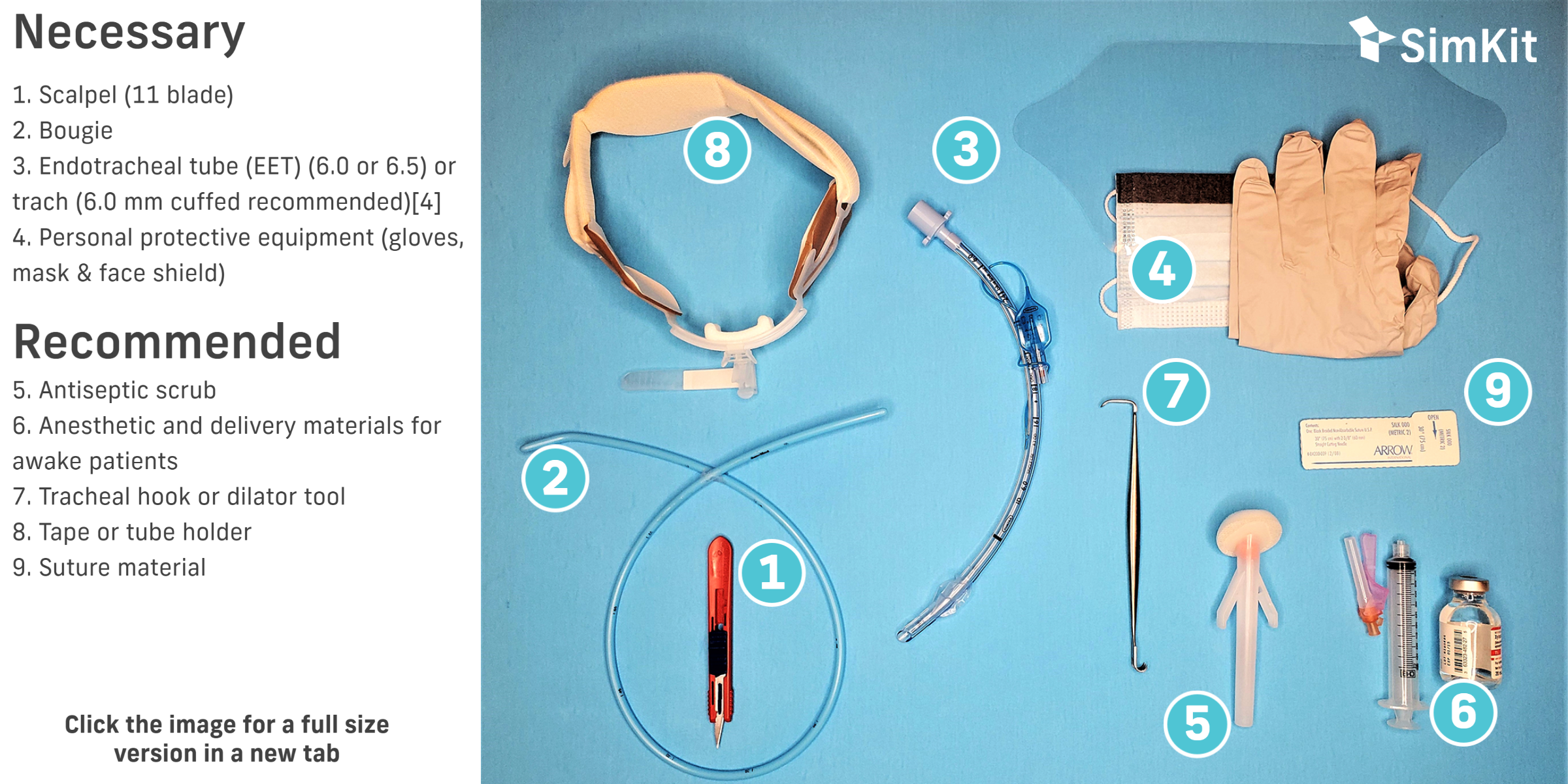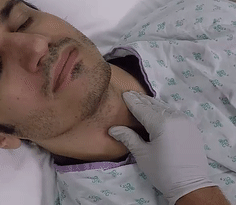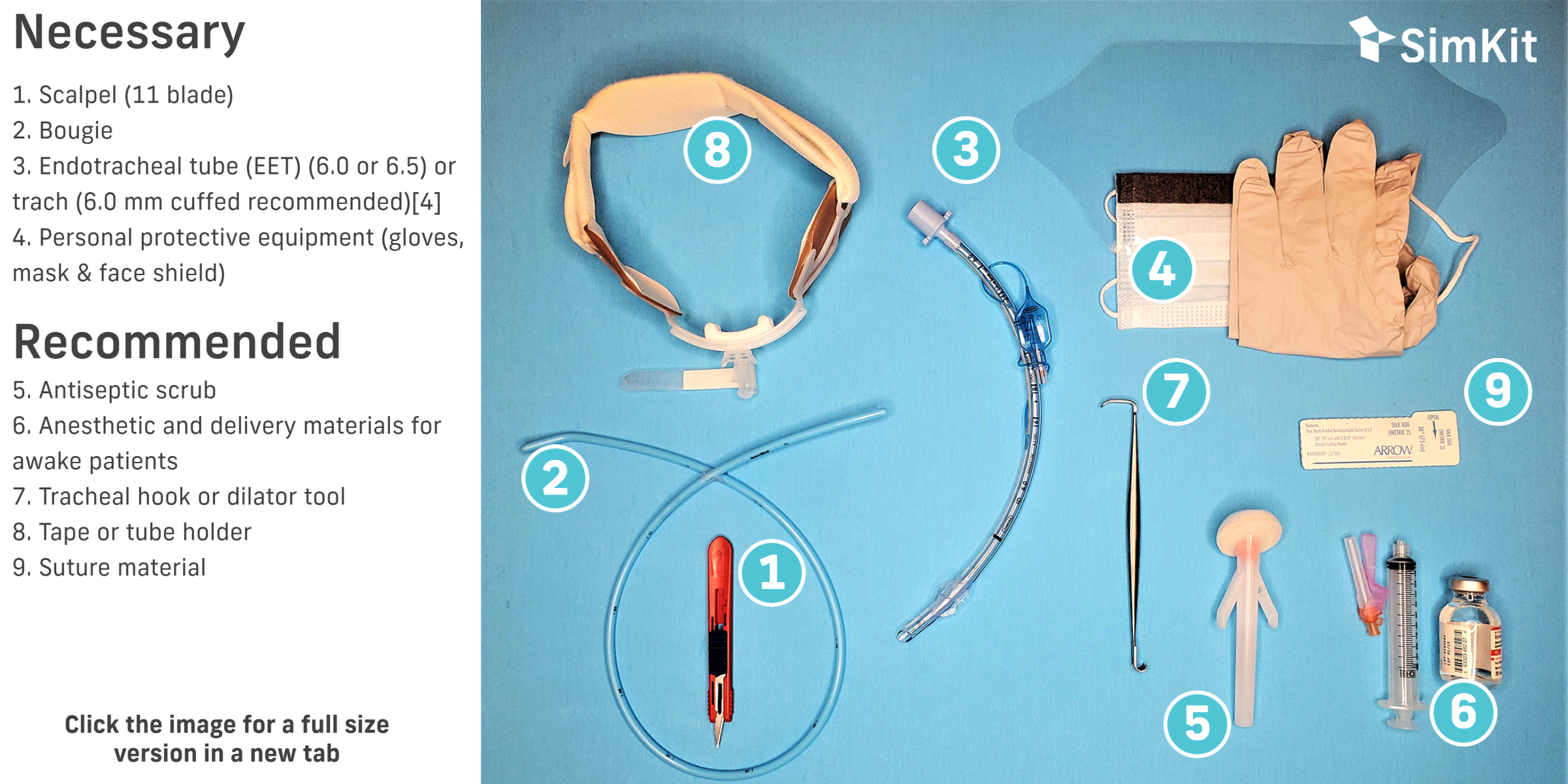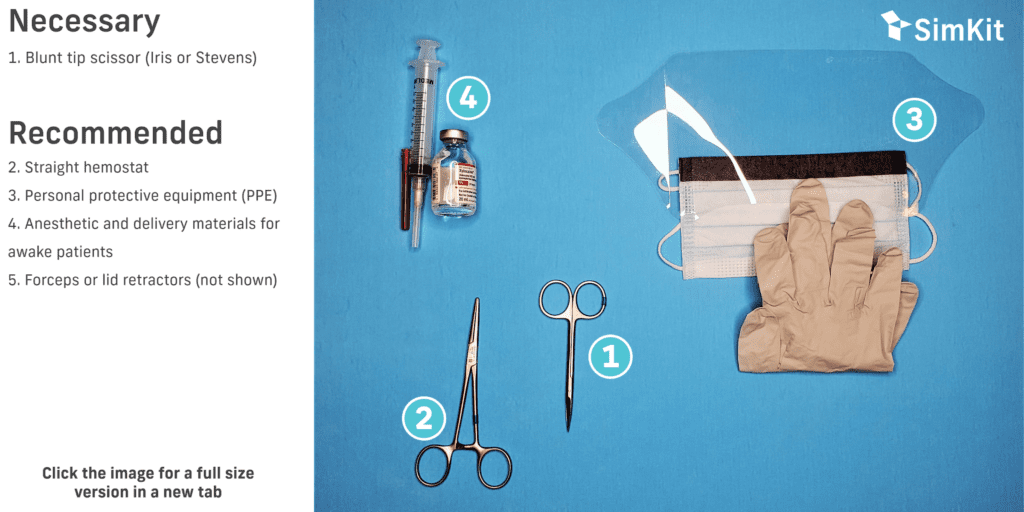Cricothyrotomy Procedure
Procedure Video
A. Indications
Inability to secure the airway by less invasive means (endotracheal intubation, supraglottic airway, bag-valve mask, etc.) in a patient with current or impending airway compromise (cannot oxygenate, cannot ventilate, cannot protect).[1]
B. Contraindications
Given the lift threatening nature of the patient’s condition, the only true contraindication is age.[1] Unfortunately, no consensus exists on this exact age, but the most referenced age cut point is 10-12 years.[1][2][3] Below this age, a needle jet ventilation system should be used. The only other contraindication to consider is having other less invasive techniques at your disposal but not utilized.
C. Materials

D. Steps
Step 1 | Landmark Identification
Several techniques are described for finding the cricothyroid membrane.
a. The laryngeal handshake (shown in gif) is the method recommended by many difficult airway groups/societies.[5][6][7]
b. Palpation of the thyroid prominence and localization to the cricothyroid membrane below it is the traditionally recommended approach.[7]
c. A upward palpation technique, termed the “modified upward laryngeal handshake” in which the clinician starts at the sternal notch and works upward has some support.[8]

Step 2 | Vertical Skin Incision
Make a vertical midline incision in the region of the cricothyroid membrane. A generous incision (3-5 cm) is recommended.[1] Palpate the membrane through the skin incision and extend cephalad or caudad as needed. Further cuts through the soft tissue may be necessary.
Step 3 | Horizontal Cricothyroid Membrane Incision
Cut horizontally through the cricothyroid membrane and into the trachea. Run your index finger of your non-dominant stabilizing hand (positioned along the patient’s mandible) along the posterior aspect of the scalpel and into the trachea, using tactile confirmation. If using a trachea hook, this can replace your non-dominant index finger. Note that tactile confirmation is harder with these devices.
Warning: Loss of tract from the skin to the trachea is a significant risk during this step. Use care to always have an object in the tract: scalpel ➡️ finger ➡️ bougie.
Step 4 | Pass Bougie
Run your bougie along your in situ index finger or tracheal hook and into the trachea. There will be tactile confirmation of trachea rings as the bougie advances and a hard stop when the bougie reaches the bronchi (likely right main stem).
Note: If using a trach, direct insertion along the finger end with obturator in place can replace bougie placement.
Step 5 | Tube Placement
Taking care not to dislodge the bougie, pass your 6.0 ETT over the bougie. Note that the tube only needs to be inserted a short distance to reach the carina. Inflate the balloon after the bougie is removed.
Step 6 | Secure Device
Using tape, an ETT holder, or trach velcro securing apparatus, secure the trach or ETT to the patient.
Note: For additional safety, many recommend securing the tube with sutures. Be sure to have confirmation of appropriate tube depth before such suturing.
Step 7 | Confirm
After securing the tube, confirm placement with chest X-ray.
Tip: If using an ETT, significant excess tubing can exist dangling from the neck, given the short course to the carina. After X-ray confirmation, you can remove the end adaptor from the tube and cut the tube to a shorter length to avoid snagging and dislodging.
**Take care not to cut the balloon inflation apparatus**
References
[1] Hebert R, Bose S, Mace S. (2017). ‘Cricothyrotomy and Transtracheal Jet Ventilation” in Roberts J. Roberts and Hedges’ Clinical Procedures in Emergency Medicine and Acute Care. Elsevier.
[2] Mittal, M. “Needle cricothyroidotomy with percutaneous transtracheal ventilation.” www.uptodate.com. Jan 2020.
[3] Patel S, Meyer T. Surgical Airway. Int J Crit Illn Inj Sci. 2014 Jan-Mar; 4(1): 71–76.
[4] Weingart S. “What Trach for Difficult Airway Cart?” https://emcrit.org/emcrit/what-trach-difficult-airway-cart/ Feb 2020.
[5] Drew T, McCaul CL. Laryngeal handshake technique in locating the cricothyroid membrane: a non-randomised comparative study. Br J Anaesth. 2018 Nov;121(5):1173-1178.
[6] Oh H, Yoon S, Seo M, Oh E, Yoon H, Lee H, Lee J, Ryu HG. Utility of the laryngeal handshake method for identifying the cricothyroid membrane. Acta Anaesthesiol Scand. 2018 Oct;62(9):1223-1228.
[7] Levitan R. “Tips and Tricks for Performing Cricothyrotomy.” https://www.acepnow.com/article/tips-tricks-performing-cricothyrotomy/2/ Feb 2020.
[8] Chang JE, Kim H, Won D, Lee JM, Kim TK, Min SW, Hwang JY. Comparison of the Conventional Downward and Modified Upward Laryngeal Handshake Techniques to Identify the Cricothyroid Membrane: A Randomized, Comparative Study. Anesth Analg. 2021 Sep 13.
Cricothyrotomy Procedure
Welcome to the Cricothyrotomy procedure page. Here we will cover indications, contraindications, materials and steps for you to master this procedure. Let’s begin below with the procedure video.
Procedure Video
A. Indications
Inability to secure the airway by less invasive means (endotracheal intubation, supraglottic airway, bag-valve mask, etc.) in a patient with current or impending airway compromise (cannot oxygenate, cannot ventilate, cannot protect).[1]
B. Contraindications
Given the lift threatening nature of the patient’s condition, the only true contraindication is age.[1] Unfortunately, no consensus exists on this exact age, but the most referenced age cut point is 10-12 years.[1][2][3] Below this age, a needle jet ventilation system should be used. The only other contraindication to consider is having other less invasive techniques at your disposal but not utilized.
C. Materials

D. Steps
Step 1 | Landmark Identification
Several techniques are described for finding the cricothyroid membrane.
a. The laryngeal handshake (shown in gif) is the method recommended by many difficult airway groups/societies.[5][6][7]
b. Palpation of the thyroid prominence and localization to the cricothyroid membrane below it is the traditionally recommended approach.[7]
c. A upward palpation technique, termed the “modified upward laryngeal handshake” in which the clinician starts at the sternal notch and works upward has some support.[8]

Step 2 | Vertical Skin Incision
Make a vertical midline incision in the region of the cricothyroid membrane. A generous incision (3-5 cm) is recommended.[1] Palpate the membrane through the skin incision and extend cephalad or caudad as needed. Further cuts through the soft tissue may be necessary.
Step 3 | Horizontal Cricothyroid Membrane Incision
Cut horizontally through the cricothyroid membrane and into the trachea. Run your index finger of your non-dominant stabilizing hand (positioned along the patient’s mandible) along the posterior aspect of the scalpel and into the trachea, using tactile confirmation. If using a trachea hook, this can replace your non-dominant index finger. Note that tactile confirmation is harder with these devices.
Warning: Loss of tract from the skin to the trachea is a significant risk during this step. Use care to always have an object in the tract: scalpel ➡️ finger ➡️ bougie.
Step 4 | Pass Bougie
Run your bougie along your in situ index finger or tracheal hook and into the trachea. There will be tactile confirmation of trachea rings as the bougie advances and a hard stop when the bougie reaches the bronchi (likely right main stem).
Note: If using a trach, direct insertion along the finger end with obturator in place can replace bougie placement.
Step 5 | Tube Placement
Taking care not to dislodge the bougie, pass your 6.0 ETT over the bougie. Note that the tube only needs to be inserted a short distance to reach the carina. Inflate the balloon after the bougie is removed.
Step 6 | Secure Device
Using tape, an ETT holder, or trach velcro securing apparatus, secure the trach or ETT to the patient.
Note: For additional safety, many recommend securing the tube with sutures. Be sure to have confirmation of appropriate tube depth before such suturing.
Step 7 | Confirm
After securing the tube, confirm placement with chest X-ray.
Tip: If using an ETT, significant excess tubing can exist dangling from the neck, given the short course to the carina. After X-ray confirmation, you can remove the end adaptor from the tube and cut the tube to a shorter length to avoid snagging and dislodging.
**Take care not to cut the balloon inflation apparatus**
References
[1] Hebert R, Bose S, Mace S. (2017). ‘Cricothyrotomy and Transtracheal Jet Ventilation” in Roberts J. Roberts and Hedges’ Clinical Procedures in Emergency Medicine and Acute Care. Elsevier.
[2] Mittal, M. “Needle cricothyroidotomy with percutaneous transtracheal ventilation.” www.uptodate.com. Jan 2020.
[3] Patel S, Meyer T. Surgical Airway. Int J Crit Illn Inj Sci. 2014 Jan-Mar; 4(1): 71–76.
[4] Weingart S. “What Trach for Difficult Airway Cart?” https://emcrit.org/emcrit/what-trach-difficult-airway-cart/ Feb 2020.
[5] Drew T, McCaul CL. Laryngeal handshake technique in locating the cricothyroid membrane: a non-randomised comparative study. Br J Anaesth. 2018 Nov;121(5):1173-1178.
[6] Oh H, Yoon S, Seo M, Oh E, Yoon H, Lee H, Lee J, Ryu HG. Utility of the laryngeal handshake method for identifying the cricothyroid membrane. Acta Anaesthesiol Scand. 2018 Oct;62(9):1223-1228.
[7] Levitan R. “Tips and Tricks for Performing Cricothyrotomy.” https://www.acepnow.com/article/tips-tricks-performing-cricothyrotomy/2/ Feb 2020.
[8] Chang JE, Kim H, Won D, Lee JM, Kim TK, Min SW, Hwang JY. Comparison of the Conventional Downward and Modified Upward Laryngeal Handshake Techniques to Identify the Cricothyroid Membrane: A Randomized, Comparative Study. Anesth Analg. 2021 Sep 13.
Cricothyrotomy Procedure
Welcome to the Cricothyrotomy procedure page. Here we will cover indications, contraindications, materials and steps for you to master this procedure. Let’s begin below with the procedure video.
Procedure Video
A. Indications
Inability to secure the airway by less invasive means (endotracheal intubation, supraglottic airway, bag-valve mask, etc.) in a patient with current or impending airway compromise (cannot oxygenate, cannot ventilate, cannot protect).[1]
B. Contraindications
Given the lift threatening nature of the patient’s condition, the only true contraindication is age.[1] Unfortunately, no consensus exists on this exact age, but the most referenced age cut point is 10-12 years.[1][2][3] Below this age, a needle jet ventilation system should be used. The only other contraindication to consider is having other less invasive techniques at your disposal but not utilized.
C. Materials

D. Steps
Step 1 | Landmark Identification
Several techniques are described for finding the cricothyroid membrane.
a. The laryngeal handshake (shown in gif) is the method recommended by many difficult airway groups/societies.[5][6][7]
b. Palpation of the thyroid prominence and localization to the cricothyroid membrane below it is the traditionally recommended approach.[7]
c. A upward palpation technique, termed the “modified upward laryngeal handshake” in which the clinician starts at the sternal notch and works upward has some support.[8]
Step 2 | Vertical Skin Incision
Make a vertical midline incision in the region of the cricothyroid membrane. A generous incision (3-5 cm) is recommended.[1] Palpate the membrane through the skin incision and extend cephalad or caudad as needed. Further cuts through the soft tissue may be necessary.
Step 3 | Horizontal Cricothyroid Membrane Incision
Cut horizontally through the cricothyroid membrane and into the trachea. Run your index finger of your non-dominant stabilizing hand (positioned along the patient’s mandible) along the posterior aspect of the scalpel and into the trachea, using tactile confirmation. If using a trachea hook, this can replace your non-dominant index finger. Note that tactile confirmation is harder with these devices.
Warning: Loss of tract from the skin to the trachea is a significant risk during this step. Use care to always have an object in the tract: scalpel ➡️ finger ➡️ bougie.
Step 4 | Pass Bougie
Run your bougie along your in situ index finger or tracheal hook and into the trachea. There will be tactile confirmation of trachea rings as the bougie advances and a hard stop when the bougie reaches the bronchi (likely right main stem).
Note: If using a trach, direct insertion along the finger end with obturator in place can replace bougie placement.
Step 5 | Tube Placement
Taking care not to dislodge the bougie, pass your 6.0 ETT over the bougie. Note that the tube only needs to be inserted a short distance to reach the carina. Inflate the balloon after the bougie is removed.
Step 6 | Secure Device
Using tape, an ETT holder, or trach velcro securing apparatus, secure the trach or ETT to the patient.
Note: For additional safety, many recommend securing the tube with sutures. Be sure to have confirmation of appropriate tube depth before such suturing.
Step 7 | Confirm
After securing the tube, confirm placement with chest X-ray.
Tip: If using an ETT, significant excess tubing can exist dangling from the neck, given the short course to the carina. After X-ray confirmation, you can remove the end adaptor from the tube and cut the tube to a shorter length to avoid snagging and dislodging.
**Take care not to cut the balloon inflation apparatus**
References
[1] Hebert R, Bose S, Mace S. (2017). ‘Cricothyrotomy and Transtracheal Jet Ventilation” in Roberts J. Roberts and Hedges’ Clinical Procedures in Emergency Medicine and Acute Care. Elsevier.
[2] Mittal, M. “Needle cricothyroidotomy with percutaneous transtracheal ventilation.” www.uptodate.com. Jan 2020.
[3] Patel S, Meyer T. Surgical Airway. Int J Crit Illn Inj Sci. 2014 Jan-Mar; 4(1): 71–76.
[4] Weingart S. “What Trach for Difficult Airway Cart?” https://emcrit.org/emcrit/what-trach-difficult-airway-cart/ Feb 2020.
[5] Drew T, McCaul CL. Laryngeal handshake technique in locating the cricothyroid membrane: a non-randomised comparative study. Br J Anaesth. 2018 Nov;121(5):1173-1178.
[6] Oh H, Yoon S, Seo M, Oh E, Yoon H, Lee H, Lee J, Ryu HG. Utility of the laryngeal handshake method for identifying the cricothyroid membrane. Acta Anaesthesiol Scand. 2018 Oct;62(9):1223-1228.
[7] Levitan R. “Tips and Tricks for Performing Cricothyrotomy.” https://www.acepnow.com/article/tips-tricks-performing-cricothyrotomy/2/ Feb 2020.
[8] Chang JE, Kim H, Won D, Lee JM, Kim TK, Min SW, Hwang JY. Comparison of the Conventional Downward and Modified Upward Laryngeal Handshake Techniques to Identify the Cricothyroid Membrane: A Randomized, Comparative Study. Anesth Analg. 2021 Sep 13.